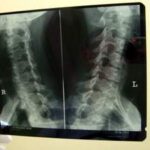The nervous system’s main function in the human body is to gather information from the outside world and reacts to it. It’s main parts include the brain, spinal cord, and all of the nerves in the body.
The brain is the most important part of the nervous system. The main parts of the brain are the frontal lobe, the parietal lobe, temporal lobe, occipital lobe, the cerebellum, and the brain stem. The frontal lobe controls behavior, intellect, and other advanced functions. The occipital lobe controls vision. The parietal lobe controls your sense of touch. The temporal lobe holds memories and speech. The cerebellum controls balance and posture. The brain stem is the sensory pathway to the rest of the body. On the lower part of the brain stem is the medulla oblongata which is responsible for controlling automic functions. Simpler organisms have a bundle of nerves called ganglia that function as a simple brain.
There are two parts to the nervous system, the Central Nervous System and the Peripheral nervous system. In both the Peripheral and Central Nervous systems, an acetylcholine acts as a neurotransmitter that activates muscles and controls movement.
The peripheral nervous system consists of sensory neurons and motor neurons that receive and act on stimulus. It is split up into two sections: the autonomic and somatic.
The automic system monitors the internal environment for dangerous changes such as fight or flight. The actions of the autonomic system are involuntary. The automic system uses two groups of motor neurons instead of one.
The parasympathetic system is an out branch of the automic system. The parasympathetic system handles less urgent changes in environment (such as sleep time and digestion). Another out branch of the automic system is the sympathetic nervous system. Its function is to regulate many homeostasis inducing changes (pupil diameter, hair growth, etc.)
The somatic branch controls the voluntary actions of your body and uses one group of motor neurons to control the body’s response.
The function of the central nervous system is to react to information obtained by the peripheral nervous system. It contains the spinal cord and the brain (also known as the Cerebrum). In the central nervous system, synapses serve as a highway for nerve impulses to travel throughout the body. The central nervous system is enveloped in a membrane called meninges.
The neuron is the basic building block of the nervous system. It sends and receives messages in the form of nerve pulses sent throughout the body.
A neuron Is made up of four separate parts The axon is a projection of the cell body that helps in sending and receiving impulses. The neuron receives signals integrates action potential and sends them to different parts of the body for a reaction. Dendrites branch out of the cell body and help to conduct electrical stimulation. Included in each cell of the body is a sodium-potassium pump, which is an enzyme that helps maintain resting potential.
A nerve impulse travels from neuron to neuron throughout the body. The dendrites pick up the impulse which releases a chemical called a neurotransmitter which binds to receptors on the neuron. The impulse is then sent to the axon for transmission to another nerve and the cycle repeats. The entire process lasts about seven milliseconds.
The reflex arc is a pathway of nerves that carries a reflex action. When the stimulus occurs (hand touching hot iron) an action potential is initiated. The action potential travels to the spine on a sensory axon that releases a chemical onto a motor nerve that contracts the muscles in the arm forcing it up and away from the dangerous stimulus.




